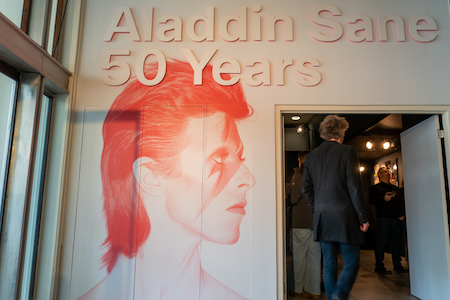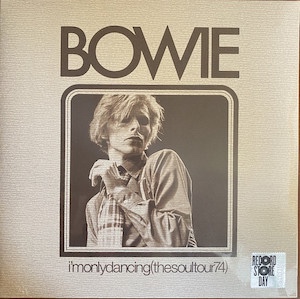The Reign of Aladdin Sane
By Emily Zoeller
David Bowie. Everyone has heard of him. But the artist was much more than Ziggy, Major Tom or the Thin White Duke. He was a musical chameleon, venturing from one end of glam rock to the other end of electronic pop. Up until his death, and even after, Bowie inspires many to reach out and find themselves, through music, fashion and art. And the Southbank Centre are here to make sure the reign of his iconic characters live on, especially Aladdin Sane, as it marks 50 years since the release of the album. Read more about the legendary life of the star here in The Reign of Aladdin Sane.
In the early 1970s, Bowie released his debut album ‘David Bowie’, which was unsuccessful and would later be released as the iconic ‘Space Oddity’. A mix of folk and rock, Bowie assembled his band The Hype, encouraging them and himself to wear eccentric, elaborate costumes.
As these outfits eventually created a persona for him, the studio sessions with the band led to the album The Man Who Sold The World. This album was a shift from Bowie’s regular folk rock style, introducing a new side to the David Bowie we knew: Glam Rock. His persona was spread worldwide to promote the album as he continued to push boundaries within his androgynous style. As Hunky Dory, his fourth album, was released, Bowie had practically encapsulated his sense of expression, and the legendary Ziggy Stardust was born.
During the Glam Rock era for the star, Bowie released The Rise and Fall of Ziggy Stardust and the Spiders From Mars, touring around the world with theatrical scenes and flamboyant costumes. The shows were almost like a performance, conveying Bowie’s alter ego in a total immersion of the character. These shows never failed to shock the audience, with one performance seeing Bowie strip down to a sumo wrestler loincloth on stage.
Later on, Bowie would abruptly announce his ‘retirement’ from his Ziggy Stardust persona, sparking fans to be left heartbroken, with rumours of audience members falling in to extraordinarily dramatic reactions. With what could have been considered a career-killing move, Bowie’s fame didn’t peak there.
This led David Bowie to continue exploring genres and personas within his music. In 1973, Aladdin Sane was released, featuring the well known photo of Bowie and his lightening bolt makeup, later becoming an emblem of his legacy. The songs featured on Aladdin Sane, including ‘The Jean Genie’, were written whilst the star travelled across the US on his Ziggy tour. Still sticking with his Glam Rock theme, Aladdin Sane incorporated rock riffs, keyboard and backing vocals.
Aladdin Sane: 50 Years exhibition at the Southbank Centre. Photo Pete Woodhead. Photo Duffy © Duffy Archive & The David Bowie Archive ™.
And ultimately, with Bowie comes some sort of alter ego. For his Station to Station tour in 1976, he became invested in soul and funk music, which heavily influenced his Young Americans album. Here, the Thin White Duke was born: an icy cool character, with slicked-back hair and sharp suits that also displayed somewhat controversial behaviour, labelling Bowie himself as a fascist.
He was not, of course. But distinguishing the character from the person, the art from the artist, was a concept not yet familiar in this time, and Bowie was deemed as a cocaine-fuelled walking controversy in The Thin White Duke era. Yet others could describe this era as telling, for many labelled him as a ‘musical chameleon’ for his shift from glam rock to soul, with soulful ballads and dance tracks.
In the late 1970s, Bowie had moved to Berlin, after discarding The Thin White Duke and moving away from his excessive lifestyle. He collaborated with icons such as Brian Eno and Iggy Pop, and released his albums ‘Low’ and ‘Heroes’. These albums were experimental, using electronic music elements, new wave and post punk influences as well as art rock influences, mixing classical music and jazz with electronic. These elements can later be heard in his album’s ‘Lodger’ and ‘Scary Monsters’.
A real shift from the mystical and darkening Thin White Duke Era, the Berlin Era showed Bowie becoming clean of drugs and meeting his long-term partner Iman. This era has inspired many others to follow in Bowie’s footsteps as these albums produced were considered classics and have influence on music to this day.
The 1980s came along, and it was goodbye Berlin Era, hello New Romantic Era. Bowie returned to his theatrical ideologies, influenced by the new romantics of music and fashion. He went back to flamboyant hairstyles and colourful costumes, and released ‘Let’s Dance!’. Bowie’s music strayed away from his electronic art rock style and focused more upon pop rock: catchy melodies, twists and incorporations of storytelling in the lyrics. This gained criticism from some, as they enjoyed Bowie’s Berlin Era and his experimental work.
During the late 80s, Bowie formed rock band Tin Machine, marking a departure from solo work and his alter egos. The songs were much more stripped down than Bowie’s other albums. The guitar-driven aesthetic was more raw, more risk-taking for David Bowie.
As the 1990s stormed through, Bowie went back to his solo music, returning to his electronic themes from the 70s and 80s, this time embedding drum and bass into albums like ‘Earthling’, which allowed him commercial success.
Running up to the millennium, up to 2012, Bowie then strayed towards neo-classist elements. This took parts of classical music and arrangements, with ‘Hours…’ incorporating a lot of acoustic themes. The Neo-classist Era also gave him a chance to evolve musically, showing he wasn’t just the electro-rock superstar everyone knew him as.
In his final years, Bowie went closer to experimental sound, focusing on his own mortality: after all, he was diagnosed with liver cancer in 2015. In 2013, he released ‘The Next Day’, his first album in a decade, and he blended all of his genres into one: rock, electronic, pop. When his final album ‘Blackstar’ was released two day before his death, he collaborated with a regular producer in his music, Tony Visconti, and allowed his legacy to live on and inspire others after his death.
It’s been 50 years since the iconic release of Aladdin Sane, Bowie’s first UK number-one album. To celebrate the release all those years ago, the Southbank Centre has introduced a new exhibition on until the end of May, created by Geoffrey Marsh and Chris Duffy, son of Brian Duffy who took the iconic Aladdin Sane album photo. This portrait allowed people to convey their own sense of identity, and remains iconic and celebrated by the Southbank Centre, including talks about the album and and archive display of all things Bowie.
Aladdin Sane: 50 Years exhibition at the Southbank Centre. Photo Pete Woodhead. Photo Duffy © Duffy Archive & The David Bowie Archive ™.
Bowie made his first debut at the Southbank Centre in 1969, during the upcoming of his Ziggy Stardust era. The exhibition is keen to display the iconic portrait by Brian Duffy, but also how Bowie reshaped his image frequently over the years. It will explore the relationship between artist and photographer, with many musical artists and poets paying tribute live on Friday 21st April in the Royal Festival Hall. An exhibition full of glam rock, Bowie-esque photography and gender identity, with a book available of never-seen-before potraits by Duffy.
David Bowie’s influence on the world of music and contemporary art has impacted not only the musical scene, but fans, and how they find their own identities and what makes them sparkle. The exhibition held in London aims to do just that and more with this extraordinary archive of everything you can think of to do with Aladdin Sane. It’s a flamboyant outlook on the life and legacy of David Bowie, and fans will not want to miss it.
Find out more about the Aladdin Sane exhibition at the Southbank Centre here.
Cover image by Aladdin Sane: 50 Years exhibition at the Southbank Centre. Photo Pete Woodhead. Photo Duffy © Duffy Archive & The David Bowie Archive ™
Listen to Aladdin Sane here on Spotify.
If you liked The Reign of Aladdin Sane, try reading Hunky Dory Turns 50.







